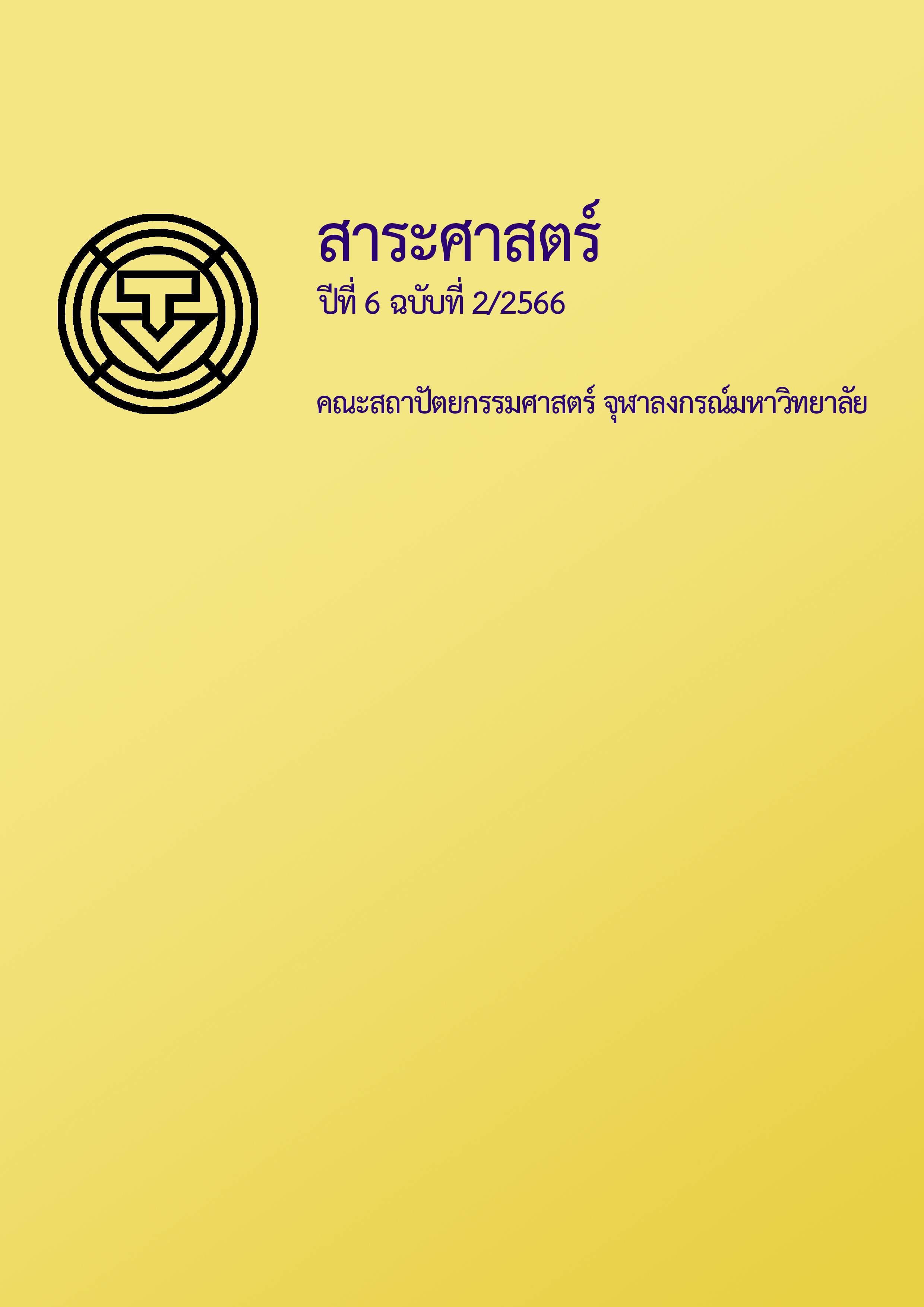การรวบรวมและจัดกลุ่มกรอบความคิดการดำรงชีวิตอัจฉริยะ จากกรณีศึกษาเชิงทฤษฎีและเชิงปฏิบัติ
Main Article Content
บทคัดย่อ
เทคโนโลยีสารสนเทศและการสื่อสารและอินเทอร์เน็ตของสรรพสิ่งเป็นหนึ่งในเทคโนโลยีพื้นฐานในยุคอุตสาหกรรม 4.0 ในขณะเดียวกัน 56% ของประชากรโลกในปัจจุบันอาศัยอยู่ในเมือง ส่งผลให้ทั่วโลกต้องเผชิญกับปัญหาการขยายตัวของเมือง และการเปลี่ยนแปลงสภาพภูมิอากาศ ด้วยเหตุนี้จึงมีการใช้เทคโนโลยีดังกล่าวเพื่อการจัดการเมืองรวมไปถึงการปรับปรุงคุณภาพชีวิตของประชากรให้ดียิ่งขึ้นและมุ่งสู่การเป็นเมืองอัจฉริยะ (smart city) ที่มีการดำรงชีวิตอัจฉริยะ (smart living) ซึ่งหมายถึงเมืองที่มีแนวคิดในการยกระดับคุณภาพชีวิตของประชาชนที่ประกอบด้วยแง่มุมต่าง ๆ ของคุณภาพชีวิต โดยในแง่ของ คุณภาพที่อยู่อาศัยเป็นส่วนที่เริ่มมีการบูรณาการเทคโนโลยีสารสนเทศและการสื่อสารในอาคารอัจฉริยะ (smart building) หรือบ้านอัจฉริยะ (smart home) มาประยุกต์ใช้เพื่อการยกระดับคุณภาพชีวิต เนื่องจากงานวิจัยที่มีการจัดการข้อมูลในส่วนนี้อย่างเป็นระบบนั้นยังไม่ครอบคลุมและเป็นปัจจุบัน ดังนั้นงานวิจัยนี้จึงมีวัตถุประสงค์เพื่อรวบรวมและจัดกลุ่มกรอบความคิดเพื่อจัดระบบข้อมูลด้านการดำรงชีวิตอัจฉริยะในแง่ของคุณภาพที่อยู่อาศัยที่มีความครอบคลุมและประยุกต์ใช้ได้ในปัจจุบัน
เพื่อให้บรรลุวัตถุประสงค์ดังกล่าว ผู้วิจัยได้ใช้วิธีถอดความคำสำคัญด้านการดำรงชีวิตอัจฉริยะในแง่ของคุณภาพที่อยู่อาศัยจากการทบทวนวรรณกรรมการศึกษาเชิงทฤษฎีและเชิงปฏิบัติ โดยคัดเลือกมาทั้งหมด 7 กรณีศึกษา ถัดมาจึงรวบรวมข้อมูล จำแนกหมวดหมู่ วิเคราะห์และสังเคราะห์กรอบความคิดการดำรงชีวิตอัจฉริยะตามลำดับ ผลจากการศึกษาพบว่ากรอบความคิดการดำรงชีวิตอัจฉริยะในแง่ของคุณภาพที่อยู่อาศัยสามารถแบ่งได้เป็น 2 กลุ่มหลัก คือการบริหารจัดการและการดำเนินการซึ่งประกอบด้วย 6 เกณฑ์ 70 ตัวบ่งชี้ พร้อมทั้งวิเคราะห์ความสัมพันธ์ระหว่างตัวบ่งชี้ในแต่ละเกณฑ์และพบองค์ประกอบพื้นฐานและช่องว่างในการศึกษาด้านการดำรงชีวิตอัจฉริยะ งานวิจัยนี้พบว่าการศึกษาเชิงทฤษฎีได้วางกรอบความคิดการดำรงชีวิตอัจฉริยะไว้เพื่อเป็นแนวทางที่ครอบคลุมมากกว่าการศึกษาเชิงปฏิบัติ กล่าวอีกนัยหนึ่งคือ การศึกษาเชิงปฏิบัติจะไม่สามารถครอบคลุมการศึกษาเชิงทฤษฎีได้ทั้งหมดจนกว่าระดับความก้าวหน้าทางเทคโนโลยีจะสามารถรองรับ การศึกษาเชิงปฏิบัติได้ ดังนั้นการรวบรวมการศึกษาเชิงทฤษฎีและเชิงปฏิบัติเข้าด้วยกันทำให้ได้กรอบความคิดการดำรงชีวิตอัจฉริยะที่มีความสมบูรณ์มากขึ้น
Article Details
References
เคนชิน. (2000). Digital Transformation คืออะไร ? https://tips.thaiware.com/1932.html#what-is-different-between-digitization-digitalization-and-digital-transformation
ฆนิศา รุ่งแจ้ง และกลวัชร หย่ำวิไล. (2563, 31 กรกฎาคม). การวิเคราะห์ปัจจัยความยั่งยืนในการพัฒนาโครงสร้างพื้นฐานด้านแหล่งน้ำในประเทศไทย โดยใช้ AHP. ใน การประชุมวิชาการด้านการชลประทานและการระบายน้ำแห่งชาติ ครั้งที่ 13 (หน้า 208-227). ปากเกร็ด นนทบุรี.
เทิดศักดิ์ เตชะกิจขจร. (2564). รายงานวิจัยฉบับสมบูรณ์ โครงการเทคโนโลยีคู่แฝดดิจิทัลเพื่อการบริหารจัดการอาคารอัจฉริยะ. สำนักงานการวิจัยแห่งชาติ.
เทิดศักดิ์ เตชะกิจขจร, ชลัมพล ธาวนพงษ์ และกวีไกร ศรีหิรัญ. (2563, มิถุนายน). ระบบการแสดงผลสภาพแวดล้อมภายในอาคารบนฐานข้อมูลสารสนเทศอาคาร. สิ่งแวดล้อมสรรค์สร้างวินิจฉัย, 19(2), 79-92. doi: 10.14456/bei.2020.11
ฤทัยชนก เมืองรัตน์. (2561, พฤษภาคม). เมืองอัจฉริยะ : การพัฒนาเมืองยุค ๔.๐. https://www.parliament.go.th/ewtadmin/ewt/parliament_parcy/download/article/article_20180523100916.pdf
ศุภมาส ด่านวิทยากุล. (2560, มกราคม-มีนาคม). บ้านอัจริยะในยุค IoT. วารสารเทคโนโลยีวัสดุ, (84), 31-34.
Amazon Web Services. (2022). IoT คืออะไร - คำอธิบายเกี่ยวกับ Internet of Things. https://aws.amazon.com/th/what-is/iot/
Ahmed, E., I., Yaqoob, I. A., Hashem, T., Khan, I., Ahmed, A. I. A., Imran, M., & Vasilakos, A. V. (2017). The role of big data analytics in internet of things. Computer Networks, (129), 459-471. doi: 10.1016/j.comnet.2017.06.013
Ajayi, O., Bagula, A., & Maluleke, H. (2022). The fourth industrial revolution: A technological wave of change. In Meisam Gordan, Khaled Ghaedi & Vala Saleh (Eds.), Industry 4.0 (Ch. 1). IntechOpen.
ARC Advisory Group. (2022). Five key industry 4.0 technologies. OTTO Motors. https://ottomotors.com/blog/5-industry-4-0-technologies
Asadian, E., Azari, K. T., & Vakili Ardebili, A. (2018). Chapter 1.5 - Multicriteria selection factors for evaluation of intelligent buildings—A novel approach for energy management. In Ibrahim Dincer, C. Ozgur Colpan & Onder Kizilkan (Eds.), Exergetic, energetic and environmental dimensions (pp. 87-102). Academic Press.
Bonneau, V., Ramahandry IDATE, T., Probst, L., Pedersen, B., & Dakkak-Arnoux PwC, L. (2017). Smart building- energy efficiency application. European Commission.
Elberzhager, F., Mennig, P., Polst, S., Scherr, S., & Stüpfert, P. (2021). Towards a digital ecosystem for a smart city district: Procedure, results, and lessons learned. Smart Cities, 4(2), 686-716. doi: 10.3390/smartcities4020035
European Parliament. (2003). History and mission. https://www.europarl.europa.eu/stoa/en/about/history-and-mission
Froufe, M. M., Chinelli, C. K., Guedes, A. L. A., Haddad, A. N., Hammad, A. W. A., & Soares, C. A. P. (2020). Smart buildings: Systems and drivers. Buildings, 10(9), 153. doi: 10.3390/buildings10090153
Giffinger, R., Fertner, C., Kramar, H., Kalasek, R., Milanović, N., & Meijers, E. (2007). Smart cities - Ranking of European medium-sized cities. Vienna University of Technology.
Gokhe, M. (2018). IV.1 information and communication technolo. TSCER. https://www.hzu.edu.in/csit/IV.1_information_and_communication_technology.pdf
Gonçalves, G. d. L., Filho, W. L., Neiva, S. d. S., Deggau, A. B., Veras, M. d. O., Ceci, F., Lima, M. A. d., & Guerra, J. B. S. O. d. A. (2021). The impacts of the fourth industrial revolution on smart and sustainable cities. Sustainability, 13(13), 7165. doi: 10.3390/su13137165
Gunatilaka, R. N., Abdeen, F. N., & Sepasgozar, S. M. E. (2021). Developing a scoring system to evaluate the level of smartness in commercial buildings: A case of Sri Lanka. Buildings, 11(12), 644. doi: 10.3390/buildings11120644
Ibrahim, M., El-Zaart, A., & Adams, C. (2018). Smart sustainable cities roadmap: Readiness for transformation towards urban sustainability. Sustainable Cities and Society, 37, 530-540. doi: 10.1016/j.scs.2017.10.008
Ivers, L., & Fleury, M. (2022). Urban development. World Bank. https://www.worldbank.org/en/topic/urbandevelopment/overview
Jain, K. (2019). Development of a smart building evaluation system for office buildings [Unpublished master thesis]. Technische Universitat Berlin.
Lu, Q., Parlikad, A. K., Woodall, P., Ranasinghe, G. D., Xie, X., Liang, Z., Konstantinou, E., Heaton, J., & Schooling, J. (2020). Developing a digital twin at building and city levels: Case study of West Cambridge campus. Journal of Management in Engineering, 36(3), 05020004. doi:10.1061/(ASCE)ME.1943-5479.0000763
Macaluso, A., Flickenschild, M., Gasparotti, A., Wedman, H., Panagiotidou, Z., Lämmel, P., Vassilev, N., Fernandez, T., Baudouin, P., & Le Gars, G. (2023). Social approach to the transition to smart cities. European Parliamentary Research Service (EPRS). doi: 10.2861/564184
Majeed, R., Abdullah, N. A., Ashraf, I., Zikria, Y. B., Mushtaq, M. F., & Umer, M. (2020). An intelligent, secure, and smart home automation system. Scientific Programming, 1-14. doi: 10.1155/2020/4579291
Merriam-Webster, s.v. (n.d.). Smart. https://www.merriam-webster.com/dictionary/smart
Muhuri, P. K., Shukla, A. K., & Abraham, A. (2019). Industry 4.0: A bibliometric analysis and detailed overview. Engineering Applications of Artificial Intelligence, 78, 218-235. doi: 10.1016/j.engappai.2018.11.007
NEW PC PLANET. (2019). Smart living with the internet of things. https://pcplanet-eg.com/smart-living-internet-things/
Omar, O. (2018). Intelligent building, definitions, factors and evaluation criteria of selection. Alexandria Engineering Journal, 57(4), 2903-2910. doi: 10.1016/j.aej.2018.07.004
Pira, S. (2021). The social issues of smart home: A review of four European cities’ experiences. European Journal of Futures Research, 9(1). doi: 10.1186/s40309-021-00173-4
Plummer, L. (2021). Insight report: Industry 4.0 and the digital transformation of cities. Smart Cities World.
Verbeke, S., Aerts, D., Reynders, G., Ma, Y., & Waide, P. (2020). Final report on the technical support to the development of a smart readiness indicator for buildings. Publications Office the European Union.
Yigitcanlar, T., Kamruzzaman, M., Buys, L., Loppolo, G., Sabatini-Marques, J., da Costa, E. M., & Yun, J. J. (2018). Understanding ‘smart cities’: Intertwining development drivers with desired outcomes in a multidimensional framework. Cities, 81, 145-160. doi: 10.1016/j.cities.2018.04.003
Zhu, Y., Zhong, N., & Xiong, Y. (2009). Data explosion, data nature and dataology. Heidelberg.

